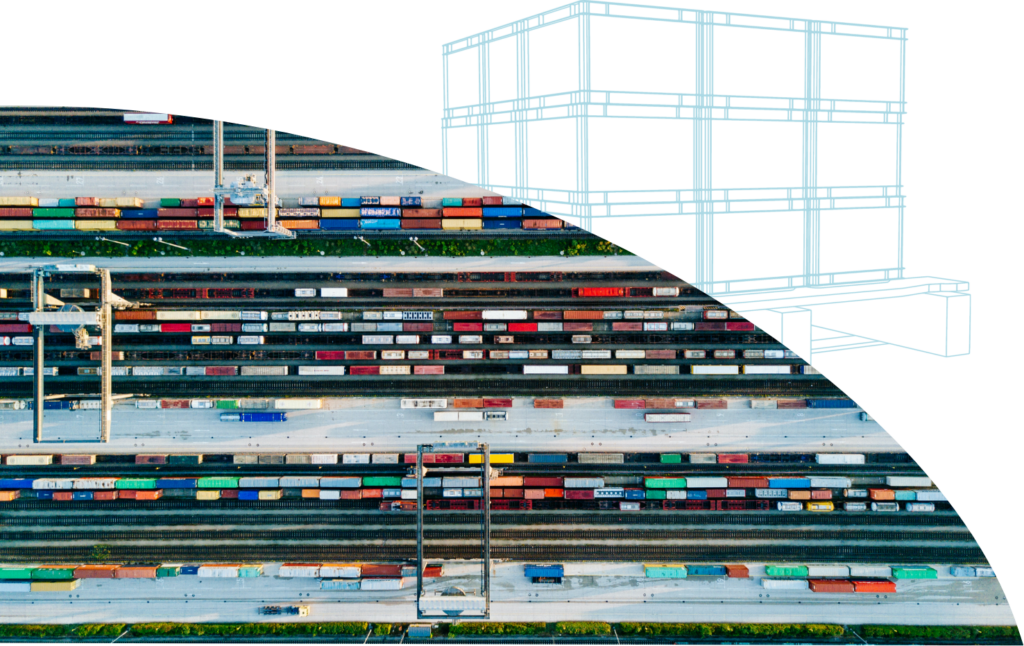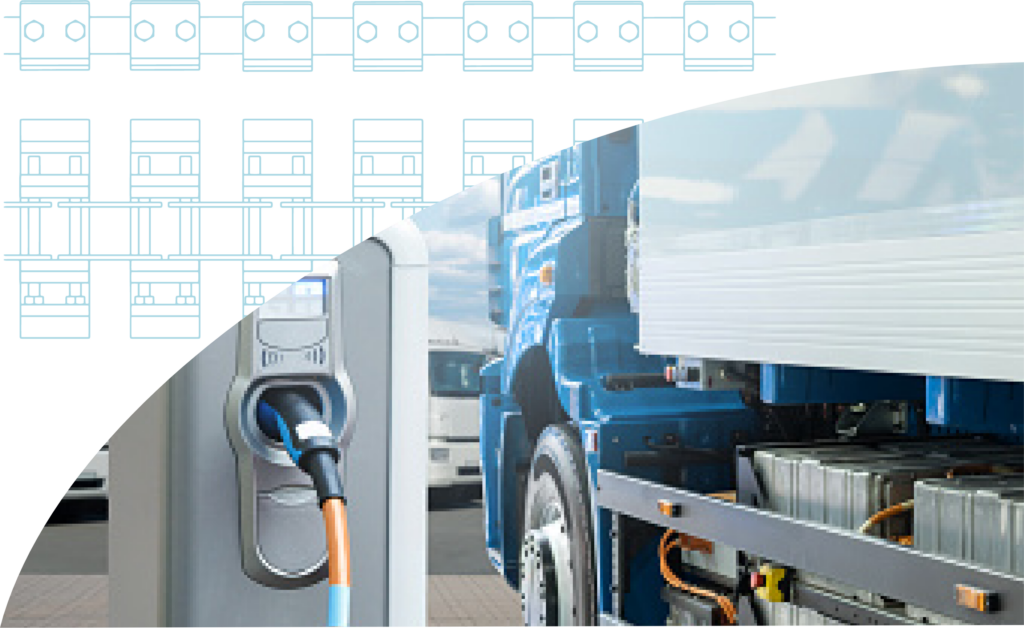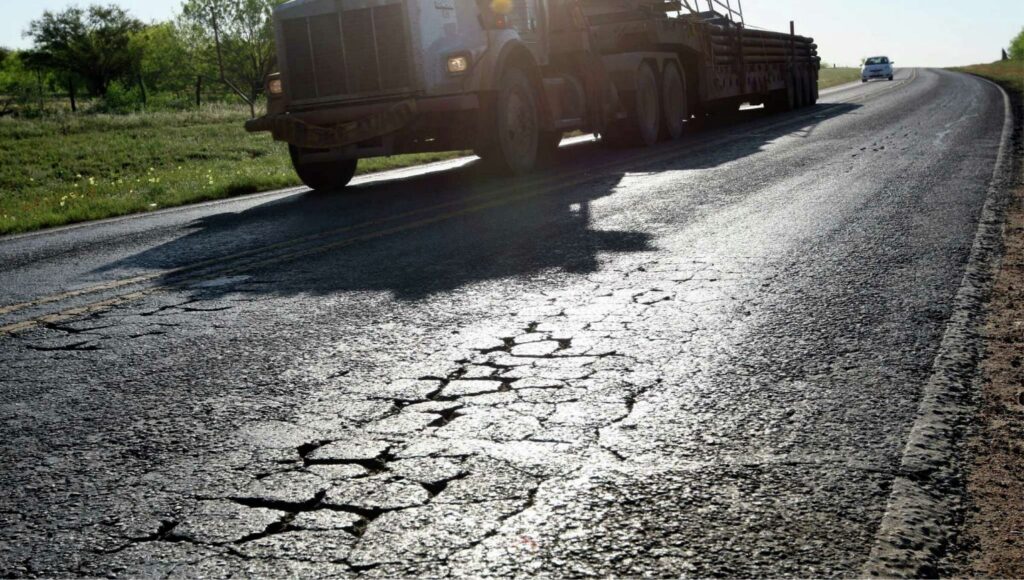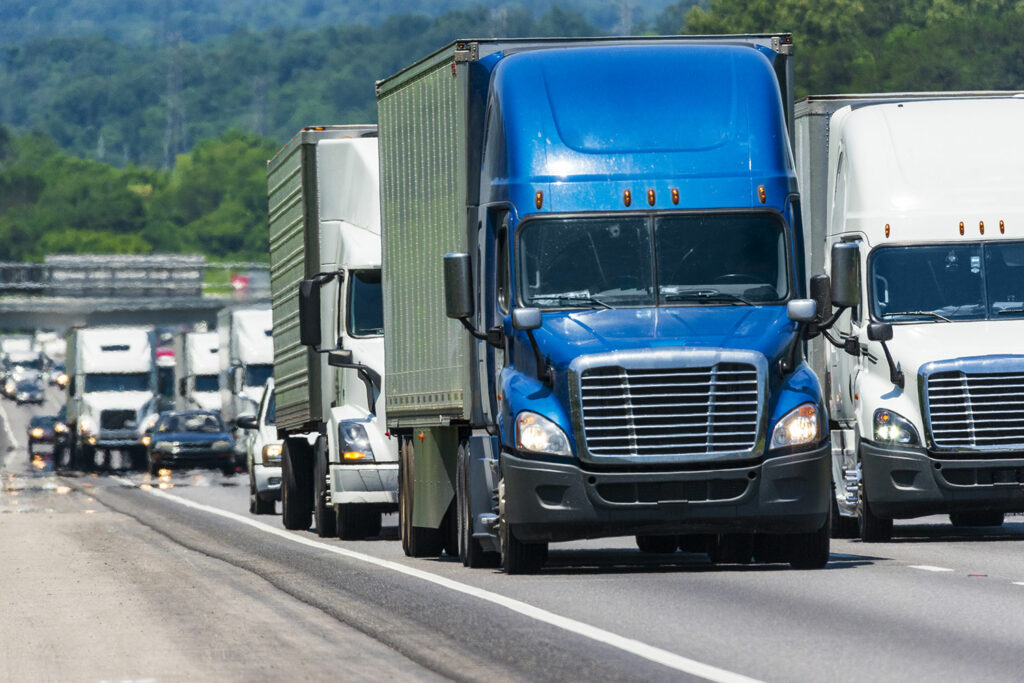Introducing a new design for railroad equipment
Enabling railroads to compete with trucking on speed and predictability of delivery times, but at a lower cost, with RAILYNX.
Introducing a new design for railroad equipment that will completely decarbonize land-based freight transportation.
Introducing a new design for railroad equipment
Enabling railroads to compete with trucking on speed and predictability of delivery times, but at a lower cost, with RAILYNX.

We place the main structural support at the top of the train with wheeled freight containers and battery packs suspended underneath using a mechanism that is secure, but easily released.

We use standardized, interchangeable components to assemble our trains rather than connecting a series of railcars.
HOW WE DO IT
The components include carriages, overhead trusses, wheeled containers and a control car at either end of the train. The support trusses are lowered into sliding couplers at the top of each carriage to form an articulated spine that runs the length of the train and provides it with linear integrity. Once assembled, these rolling stock components are not routinely disconnected, eliminating coupling and slack action from train operations and delivering a much smoother ride for sensitive freight.
Each carriage is equipped with brakes and motive power so the train’s control system can alleviate linear stress and permit a lighter, less expensive equipment design with a lower and more energy efficient tare/load ratio.
As a Railynx train enters a terminal, the floor elevation adjacent to the rails will gradually rise until each container's wheels are supporting its own weight. Our software will track where arriving containers are located on approaching trains, so departing containers can be positioned accordingly. The train is stopped when arriving containers reach the exchange stations where departing containers are waiting. The arriving containers are then disconnected and rolled to the side of the train as departing containers are moved into position and attached. Swapping out the rechargeable battery packs will follow this same process.
Key OPERATIONAL ADVANTAGES
The positioning of Railynx trains within the terminals and the operation of the exchange stations will be fully automated so multiple freight containers can be loaded and unloaded simultaneously without being lifted or disconnecting any of the rolling stock components.
By assembling our trains with interchangeable components and equipping the containers with wheels:
Our freight containers can be sorted by destination at the terminals between train arrivals and without the need to use rolling stock.
The automated exchange of containers and battery packs will minimize terminal dwell times and keep the freight moving.
Any needed repair or maintenance on a train component will take only a minor equipment investment offline.
Level the Playing Field
The railroads recognize that classification yards slow their deliveries so they developed an improved intermodal service using unit trains to bypass them and double-stacked well cars to increase train capacity. This service is now the largest and fastest growing portion of railroad freight revenue. While successful, this approach still has serious limitations.

Intermodal terminals require large land areas and heavy lift cranes to offload, stack, reshuffle, and load freight containers.
This typically locates them far outside population centers, leading to increased drayage distances and higher delivery costs. Crane operations are a bottleneck that cause 40-hour dwell times for containers and such high fixed costs at either end that only shipments traveling more than 500 miles are price competitive with trucking. This limits their reach since 80% of freight moves are shorter than 500 miles.
With fast, automated terminals, our trains can serve the many intermediate locations that unit trains currently bypass, without appreciably impacting transit times.
By placing our terminals throughout the country, we can extend clean, efficient freight rail service to many currently underserved communities.
Our exchange stations will be indoors and since coupling and slack action aren’t needed, our terminals will be quiet, pollution-free neighbors that can be located closer-in, reducing drayage distances so the last leg of the trip can be by battery-powered trucks.

THE STATUS QUO IS CLEARLY UNSUSTAINABLE
The Congressional Budget Office (CBO) has determined that moving freight by truck imposes external costs on our society at a rate 8 times higher than moving freight by rail. These costs include wasted fuel and man-hours sitting in traffic congestion, highway pavement damage, adverse health effects from air pollution and traffic deaths and injuries from car-truck collisions.
More than $200 billion in taxes are spent on highway and bridge maintenance each year and 95% of the pavement damage caused by vehicle use is due to heavy trucks.

According to the American Society of Civil Engineers (ASCE), 43% of our public roadways are already in “poor” or “mediocre” condition.

From 2000 to 2019, total vehicle miles traveled on our Interstate highways increased 26% while lane miles increased just 9%, indicating traffic volume is growing at nearly triple the rate that new lane capacity is being added, a recipe for more congestion.
The ASCE estimates that the deficient and declining state of surface transportation could cost Americans almost $3 trillion in declining business productivity and personal budget impacts by 2040.
Expanding and maintaining our highway system is expensive and government funding has not been keeping up. Meanwhile, freight volume is expected to grow by more than 50% by 2050, placing ever greater stress on the nation’s roadways.
Since the railroads maintain their own infrastructure, we can avoid much of this increased congestion and further deterioration of our highway service levels while saving billions in taxes, by shifting more freight to rail. Railynx equipment can facilitate this shift.
Key Beneficiaries
Placing 80,000-pound trucks and 4,000-pound cars on the same roads has had a detrimental impact on traffic safety. A Government Accountability Office (GAO) study determined that trucks cause 6.4x more fatalities and 16.9x more serious injuries per ton-mile than rail transport.
Adverse health impacts and early death, due to toxic air pollution from diesel exhaust and particulates from tire, brake and pavement wear cost billions each year in added healthcare costs, particularly in communities adjacent to major freight corridors.
Our supply chains are vulnerable to fluctuating oil prices and driver shortages. Railynx will increase the resiliency and carrying capacity of our nation’s transportation infrastructure with little additional investment since the railroads are already in place.
Traffic congestion wastes 3.3 billion gallons of fuel each year, enough to fill a line of 18-wheel tanker trucks stretching from Los Angeles to Boston. The cost of wasted fuel and lost man-hours grew from $15 billion in 1982 to $179 billion in 2017 and continues to increase.
Congestion costs imposed on the trucking industry has increased 35% over the past 5 years alone, adding billions to the price of everything that moves by truck.
The poor condition of our highways is forcing the nation’s motorists to spend nearly $130 BB each year in extra vehicle repairs and operating costs, about $700/yr. for the average driver.
Regulators, investors and customers are pressing businesses to account for and reduce their carbon footprint and freight transportation is a major contributor. Railynx will offer them a decarbonized service.
We will pick-up loaded containers with electric trucks and deliver them to their final destination the same way, with the long-haul portion of the trip on a Railynx train. This portal-to-portal service will simplify a marketplace that has grown so complex that the Third-Party Logistics (3PL) industry evolved to help navigate it.
Our service will reduce handling, breakage and inventory shrinkage costs since shipments will move in locked containers and either be moving or housed inside a secure terminal or warehouse.
$1 trillion is spent each year on freight transportation in the U.S. alone, $800 billion on trucking, but only $70 billion on rail. A 10% penetration rate into the trucking market will more than double railroad revenues.
Since Railynx containers will also be moved on the highways, they must conform to highway weight limits. Consequently, Railynx equipment and the loads they carry will be much lighter than conventional railroad equipment, causing little if any additional wear and tear on their infrastructure.
Lighter equipment carrying lighter loads with a more responsive control system will improve braking performance and allow our trains to travel closer together. This, combined with brief terminal stops, will increase the carrying capacity of existing rail infrastructure.
By decarbonizing freight transportation, Railynx will elevate the railroad industry’s relevancy as we transition to a more sustainable future.

